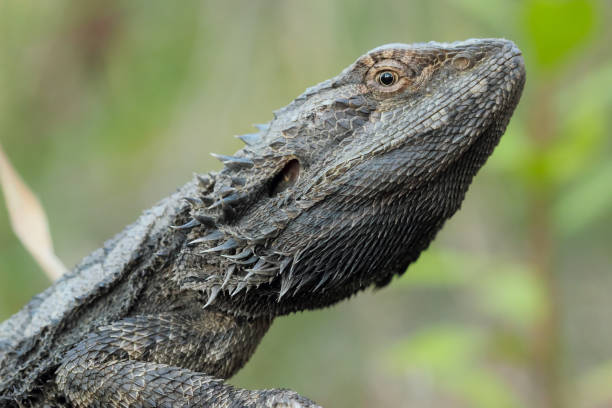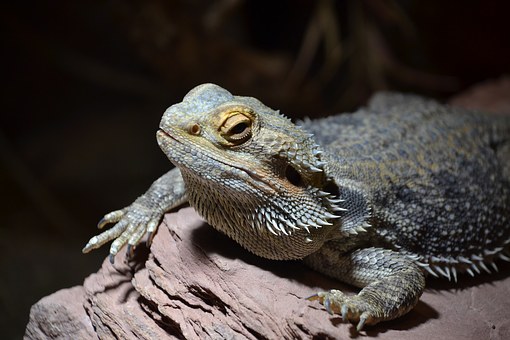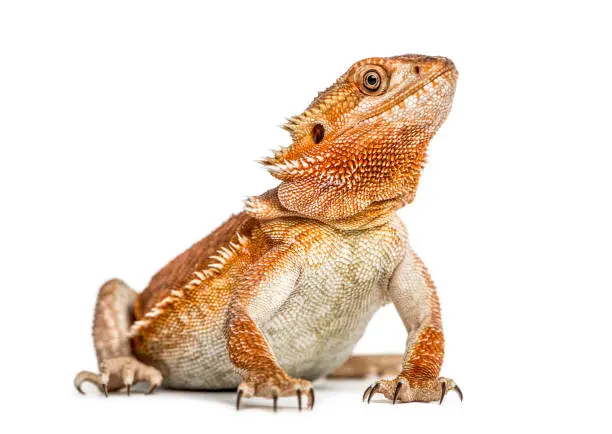What Are Bearded Dragon Fat Pads? Bearded dragon fat pads are essential fat stores that look like small pockets on a bearded dragon’s head behind the eye sockets, chin, belly, and tail. The fat pads appear to be sufficiently filled and slightly rounded in a healthy bearded dragon lizard. On the other hand, an unhealthy lizard will be seemingly a bearded dragon with no fat pads or sunken fat pads.
There are several physical signs to watch out for when determining if your bearded dragon is in a healthy weight. One of the most obvious signs is sunken in or protruding fat pads.
Read on to learn all about bearded dragon fat pads’ purposes and what they say about the well-being of the lizard.
In this article
Functions of Bearded Dragon Fat Pads.
Healthy bearded dragon fat pads are bulgy and feel squishy when full of fats. They are constantly replenished in a well-fed bearded dragon. However, these fat pads on bearded dragons are often drawn out during long periods of starvation or when the lizards are shading.
Below is a list of roles fat play in reptiles;
- Energy replenishment during starvation or periods of dormancy. These included brumation and skin shedding periods.
- Fat utilization for reproduction.
- Useful for heat distribution in cold seasons.
Delve into this Publication of Lipid Storage and Utilization in Reptiles by W. Kenneth Derickson.
How do I know if my bearded dragon is malnourished?
How to tell if a bearded dragon is too skinny is an essential skill that responsible bearded dragon keepers must master. Here are signs of an underweight bearded dragon to look out for;

1. Sunken Bearded Dragon fat pads
Bearded dragon’s eyes are the most apparent spots on its body to check for signs of undernourishment. Cratering or depressions in place of bearded dragon fat pads are telltale signs that the dragon’s fat reserves are running low.
2. Loose Bearded Dragon skin
Loose skin on a bearded dragon is a critical sign that the lizard has exhausted its fat reserves. Try to re-hydrate the bearded dragon and restore its feeding schedule if it is not in the natural dormancy season.
3. Visible ribs on bearded dragon
It is common for some pets, such as dogs, to have visible ribs. For your bearded dragon, it is only acceptable if you can only feel the ribs when touching their belly.
However, it is not okay to clearly see your bearded dragons’ ribs. You know your bearded dragon is not doing well when its ribs are protruding. Have an immediate plan in place to improve its diet.
4. Thin Bearded Dragon tail
Your bearded dragon fat pads on its tail should keep the tail in form and not disfigured in any way. If you notice a bony tail in your bearded dragon, it is a call for proper nutrition.
5. Low energy and a shaky bearded dragon
Malnourished bearded dragons tend to show several symptoms that can cause concern. They may be lethargic, appear to be uninterested in their surroundings, and may even begin to shake. In such extreme cases, seek vet services for professional advice to better care for the lizard.
How can I make my bearded dragon gain weight fast?
Before delving into how to fatten up a skinny bearded dragon, first consider its age. Adult bearded dragons should be approximately 18″ -24″ long and weigh up to 20 ounces, while juvenile bearded dragons should weigh under 12 ounces.
These three broad steps are critical in helping your bearded dragon fat pads to be replenished and add weight;
1. Identify and address the underlying cause
Never skip the critical step of finding out the root cause of a problem before addressing the symptoms. You may discover that an infection caused the bearded dragon’s underweight problem. In that case, your bearded dragon may require priority treatment.
Your bearded dragon’s veterinarian will take a physical exam and perform various lab tests before providing a treatment plan. If your vet can successfully treat your bearded dragon, they will advise on the next step in addressing the weight problem.
It is also possible that your bearded dragon is being bullied by their cage mates, if any. Bearded dragons are naturally competitive, so you should avoid keeping them in the same enclosure.
More giant bearded dragons will most likely dominate the smaller lizards and deprive than of food. This will result in stress, starvation, and weight loss for the smaller bearded dragons. Bear in mind that stress will also drastically undermine their immune system.
If your beardies’ weight loss is due to competition and stress, then maybe you should give them a break by moving them to a different cage. That will help your bearded dragons feel happier and have enough food.
2. Provide a proper diet to your bearded dragons
The most effective way to feed your bearded dragon is to use a high-fat, nutritious diet. Preferably, your should feed young bearded dragons of under six months with a diet that consists primarily of protein. After that, you should start transitioning from a high protein to vegetable and fatty foods diet on their year anniversary.
It’s best to feed your bearded dragon (and any other reptile) at least twice a day. However, it is recommended for a bearded baby dragon to avoid offering insects until it is about 15 inches long.
Bearded dragons are insectivorous reptiles. They feed on crickets, mealworms, waxworms, and super worms. However, too many of these insects can result in intestinal blockages.
3. Provide a conducive living environment for bearded dragon
The UVB light is vital for the growth and overall health of the bearded dragon. Ensure you also provide a basking stop where the bearded dragon can enjoy temperatures between 90-105 degrees Fahrenheit.
It’s essential to provide a suitable environment for the bearded dragon to maintain its health and vitality as it grows. Their enclosures must be free of typical sources of bearded dragon stress like;
- Too much light
- Extreme noise
- Other pets that could bully the bearded dragons
- Drastically fluctuating temperatures
- Inappropriate humidity
- Unhealthy competition for food among bearded dragons. Have a look at this article on how competitive bearded dragon can be.
What if my bearded dragon won’t eat?
If your pet bearded dragon is not eating for over a week and yet all aspects of its habitat are optimal, you should urgently take it to a veterinarian. The reason is simple. Your bearded dragon is most likely having medical problems.
A veterinarian can help you determine any health issues, whether general or specific and treat them accordingly.
A vet can also help with the diet and nutrient intake. For example, it’s essential to monitor and follow the appropriate feeding schedule as overfeeding during starvation can, unfortunately, result in sudden death.
How fat should my bearded dragon be?
The weight of your bearded dragon, particularly as it gets older, is a crucial consideration in determining whether your pet is overweight or obese.
Generally;
- A 6-month-old bearded dragon weighs between 100 grams – 130 grams.
- At 1 Year, a healthy bearded dragon is expected to attain its maximum weight of between 250 grams and 350 grams.
- On the higher side, it is okay to have a bearded dragoon of 20-24 inches long, weighing up to 750 grams.
- Any bearded dragon weighing above 850 grams is considered obese or overweight.
However, be careful not to confuse a pregnant/gravid bearded dragon or constipated bearded dragon to be overweight. If you are positive there is no pregnancy or manageable impaction, this could be a tumor or retained fluid. Contact a vet immediately.
A 1-year-old female bearded dragon will show signs of being gravid if;
- She looks restless
- She keeps scratching the tank
- It doesn’t move as much
- Significantly gains weight even with a regular diet and pooping times becomes irregular.
How can you tell if a bearded dragon is overweight?

Start worrying if you have any bearded dragon that weighs over 800 grams and is shorter than 22-24 inches long. However, bearded dragons weighing below could be at risk of being obese if they show the following signs;
- They start developing complications relating to bones and joints
- Movement is drastically impaired
- Most of them are often tired
Keep in mind to rule out brumation and being gravid in bearded dragons.
How does being overweight affect bearded dragon’s health?
Being overweight can be a big problem. It means that your bearded dragon will carry more weight. The bones and joints will be weakened, so your bearded dragon is more likely to be overly inactive and eventually lose essential body functions.
An obese bearded dragon has a higher risk of developing a fatty liver. Females will most likely face egg-binding, and fat released into the bearded dragons’ system may cause organ dysfunction.
How to make your overweight bearded dragon fat pads lose weight?
Below are some of the simple techniques you can practice to help your bearded dragon to lose extra weight;
- Ensure your bearded dragon is not getting fed too much fatty insect-based food.
- It’s better to give your bearded dragon fewer times in a day.
- Engage your bearded dragon in having him hunt for food. Ensure movement around the habitat is encouraged.
- Train your bearded dragon to eat salads and introduce them into its diet.
- Consult your vet on recommended detoxifying supplements for your bearded dragon.
Conclusion.
Bearded dragon fat pads affect the whole well-being of the lizard. They must be keenly monitored for crucial signs.
The bearded dragon fat pads must not be depleted/underweight or too full obese/overweight for a healthier and happy pet.

